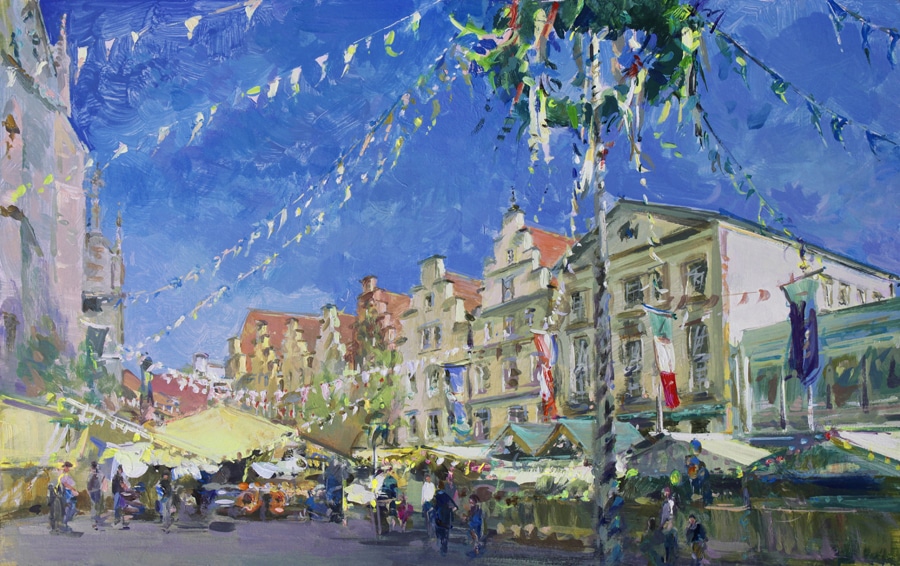As a fellow “Artrepreneur,” I understand that being the salesperson for your art isn’t always the easiest thing to do. We’d much rather spend time creating than selling, but taking the time to create a good sales approach is key to increasing your success. Here are 10 straightforward ideas that are sure to power up your sales.
1. Develop a distinctive and consistent vision. Don’t spread yourself all over the artistic map or your customers will get lost. If you try to satisfy all of your creative whims and customers’ tastes, you will end up satisfying no one. Strive to be the best artist in your niche. Move forward with pride and confidence. Georgia O’Keeffee said, “I had to create an equivalent for what I felt about what I was looking at — not copy it. To create one’s world in any of the arts takes courage.”
2. Know your customer and “customer profile.” Look at your top buyers. Where do they live and spend vacations? What are their professions, special interests, ages and life styles? What kind of art do they purchase and at what price levels? This information describes your customer profile. You can then determine where to place your efforts to attract more clients who match the profiles.
3. Know why your work is selling. Record the reasons your customers give when they decide to make the purchase. What qualities attracted them the most? Then follow up after they have hung your work to learn how much they enjoy living with it and why. This information is valuable for making future sales proposals.
4. Spend money to make money. Experts say you should spend at least 10 percent of your gross sales on promotion and marketing. Spend it wisely based on a sound financial plan. Don’t skimp on the essentials: Web site design, printed materials, and experienced legal and other professional services. For information on setting a marketing budget, read Create a Marketing and Communications Budget by Ligaya Figueras.
5. Make your next reception memorable. Whether it be at a prestigious gallery or an Open Studio, create a special ambiance that will attract people, keep them there and make a lasting impression on them. (The same is true of your Web site!) Be different. It can be as simple as having live music or a “Champagne and Chocolates” reception or a live portrait demonstration. For more information on hosting art events, refer to my article 14 Tips for Creating Outstanding Art Events in the June 2010 issue of Art Calendar.
6. Build second tier relationships. It is important to reach out to your ultimate buyer but equally important to establish relationships with those they rely on for leads and expertise. Your relationships should be with interior designers, architects, real estate agents, house stagers, corporate buyers and private art dealers. Let them bring the buyers.
7. Network outside your circle. Think creatively. Talk to your banker, accountant, dentist, florist and doorman. Ask them for business referrals, and do the same for them. My stepfather gave me my first lesson on marketing through networking. He was a diet specialist and told me that he built his hefty medical practice getting referrals from his tailor.
8. Keep close contact with your best buyers. There is a general business rule that says 80 percent of your sales come from 20 percent of your customers. It would be wise to focus attention on your most productive markets. Consider sending out a special mailing, or even making direct phone solicitation, to the 20 percent of your customers who have bought the most from you in the past. Share information regularly with them about your newest pieces, as well as career achievements, new artistic projects. This has become a simple task through e-newsletters and Web blogs. Also ask them to forward the news to friends and associates.
9. Diversify, diversity, diversity. I like to use the rule of thirds. Set up three different promotion and marketing practices and use them regularly: direct mail, e-mail marketing and word-of-mouth. Also set up three different price brackets for your work — for example, low, “out-of- pocket” sales; medium price sales; and highest price sales. By offering your customer choices, they will ask themselves, “Which one shall I buy?” instead of asking, “Should I buy or not buy?”
10. Be consistent and persistent. Whether the market is up or down, whether the weather is hot or cold, your confidence and your activities should be unrelentless and steady. Set aside a block of time each week to devote to marketing and promotion. You will find the time spent really worthwhile. Never, never, never give up.
Renée Phillips, The Artrepreneur Coach, is the author of several books and publications, which can be found on Manhattan Arts International. She organizes exhibitions related to the healing power of art and offers advice to artists in private consultations and on her blog. She invites you to follow her on Twitter, and join her on Facebook and LinkedIn.




